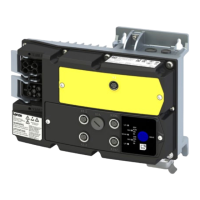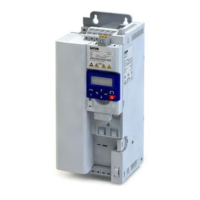8.2.5 Sensorless control for synchronous motors (SL-PSM)
The sensorless control for synchronous motors is based on a decoupled, separated control of
the torque-producing current and the current in eld direcon. In contrast to the servo con-
trol, the actual speed value and rotor posion are reconstructed via a motor model.
NOTICE
In case of this motor control type, an adjustable, constant current is injected in the lower
speed range. If this current is higher than the rated motor current, the motor may heat up in
the lower speed range. This eect increases if the motor is operated in the lower speed range
for a longer period of me.
Possible consequence: Destrucon of the motor by overheang
▶
Do not operate the motor for a longer period of me in the lower speed range.
▶
For detecng and monitoring the motor temperature, we recommend a temperature feed-
back via PTC thermistor or thermal contact. 4Motor temperature monitoring ^ 219
Precondions
The sensorless control for synchronous motors (SL-PSM) is possible up to a rated power of
maximally 22 kW.
Details
This motor control type is acvated by seng 0x2C00 (P300.00) = "Sensorless control (SL
PSM) [3]".
The motor model-based speed observer requires a rotang machine. Thus, as a maer of
principle, the operaonal performance of the sensorless control for synchronous motors is
divided into two ranges:
1.
Low speed range (|setpoint speed| < lower limit 0x2C11:001)
•
In the range of low speed, the speed of a synchronous motor cannot be observed. In
this "Low speed range", an open-loop controlled operaon takes place: For accelera-
on processes, the current set in 0x2C12:001 is injected and for processes without
acceleraon (for instance standsll or constant setpoint speed) the current set in
0x2C12:002 is injected.
2.
High speed range (|setpoint speed| > lower limit 0x2C11:001)
•
In this area, the rotor ux posion and the speed are reconstructed by means of an
observer. The control is executed in a eld-oriented way. Only the current required for
generang the necessary torque is injected.
Pole posion idencaon (PLI)
•
For controlling a permanent-magnet synchronous motor, the pole posion - the angle
between the motor phase U and the eld axis of the rotor - must be known.
•
In case of a drive at standsll, the inverter enable is directly followed by the "pole posion
idencaon (PLI)" which idenes the inial pole posion.
Flying restart circuit
•
From rmware version 4 onwards, a ying restart circuit for the synchronous motor up to
speeds lower than half the rated speed is supported.
•
If the ying restart circuit shall be used, set the start method "Flying restart circuit [2]" in
0x2838:001 (P203.01). More sengs are not required for the ying restart circuit at sen-
sorless control of a synchronous motor.
For a speed control with torque limitaon in operang mode 0x6060 (P301.00) = "MS: Veloc-
ity mode [-2]":
1.
Select the source in 0x2949:001 (P337.01) for the posive torque limit source and set it
accordingly.
2.
Select the source in 0x2949:002 (P337.02) for the negave torque limit source and set it
accordingly.
Motor control
Motor control selecon
Sensorless control for synchronous motors (SL-PSM)
178
